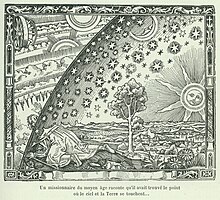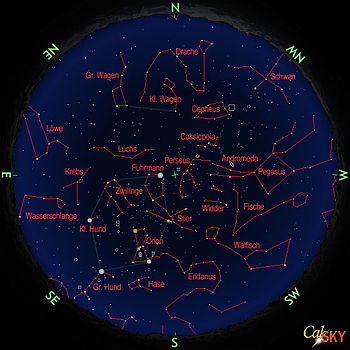starry sky
Under a starry sky or starry sky , the sight of the starry is heaven understood - the cloudless night sky on Earth or on other celestial bodies and the universe .

Under favorable circumstances, at locations on Earth are without light pollution to the naked eye about 3,000 to 6,000 stars to see - all at the galaxy include (Milky Way) - and also the Andromeda galaxy and the two Magellanic Clouds freiäugig visible. The number of stars that can be seen with modern large telescopes is over 10 billion.
The phenomenological celestial phenomenon is also referred to as the firmament , to which the fixed stars , immovable against each other, were previously thought to be attached. From a mathematical point of view, the view of the sky for spherical astronomy is the projection of star space onto the so-called celestial sphere , a unit sphere used for calculations .
Hemispheres
With reference to the celestial sphere , hemispherical halves or hemispheres can be distinguished for the starry sky, separated by a separating plane.
- The sky visible above the horizon represents one half with the zenith (vertex), the other half with the nadir (base) lies below the horizon level of the location.
- The plane of the celestial equator divides the starry sky into two hemispheres: the northern sky around the northern celestial pole and the southern sky around the southern celestial pole .
- In relation to the plane of the ecliptic - the apparent annual orbit of the sun against the fixed star background of the zodiac - the starry sky can be divided into half north of the ecliptic around the northern ecliptic pole and half around the southern ecliptic pole.

Different astronomical coordinate systems can be established based on a plane as the reference plane and an axis standing on this as the coordinate axis . For example, on the horizon plane with the observer as the center and his location as the reference point and here the direction of the plumb as the vertical reference axis between zenith and nadir, the well-known horizon system is established, a topocentric reference system in which stars with horizontal ( horizontal angle as azimuth ) and vertical ( height angle as elevation) coordinates can be located.
In contrast, terms such as summer sky or winter sky refer to the changing aspect of the starry sky and therefore depend not only on the geographical location, but also on the local time and the seasonal date. For example, the winter constellations of the evening sky typical of Europe , such as Orion , can also be seen in autumn , but after midnight .
Starry sky as a reference system
In astrometry and spherical astronomy, the starry sky serves as a reference system for fixed coordinates , sidereal periods and universal time (UT). See also time systems and fundamental system .
It gives geodesists , navigation and various branches of physics the opportunity to measure absolute directions , perform localizations and determine the shape of the earth : The reference systems for coordinates and physical measurements are ultimately derived from the starry sky. Its determining parameters and those of the earth are defined uniformly internationally - with the umbrella associations of astronomers ( IAU ), physics, geophysics ( IUGG ) and geodesy ( IAG , FIG ) cooperating closely.
Star maps
Star maps , in particular rotatable star maps that can be set according to date and time, are used for orientation in the starry sky . As a rule, they are designed to face south . For other viewing directions, the desired cardinal direction should be held down. The cardinal points are usually marked with N (north), E (east), S (south) and W (west).
The Nebra Sky Disc is the oldest representation of the starry sky - and the star cluster of the Pleiades .
Seasonal starry sky
The following tables show the evening or night view of the sky at different times of the year for Central Europe in the months of January, April, July and October - each around 9 p.m. in the middle of the month.
The maps show stars up to about 4th size , the usual contours of the constellations as well as the winter hexagon and the summer triangle . The vertex ( zenith ) is in the center of the map. The direction in which the observation takes place must be taken into account and the map adjusted by rotating it.
literature
- Ernst Seidl: Heaven. Ideal image and understanding of the world . MUT, Tübingen 2011, ISBN 978-3-9812736-2-5 .
Web links
- The complete starry sky (simulation) Requires Java
- Stellarium - free astronomy program Stellarium with photo-realistic starry sky
- Current starry sky with constellations, planets, lunar calendar (Bayerischer Rundfunk)
- sternenhimmel-aktuell.de - A guide to the starry sky by Richard Nachtigall
- Scenes from two hemispheres - Astronomy Picture of the Day from January 15, 2010.




